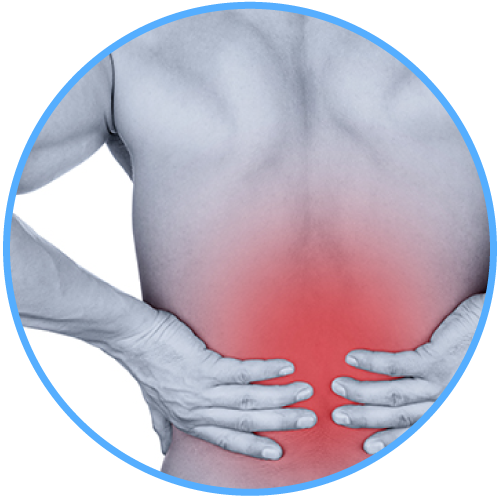
Herniated/prolapsed disc
Terminology about spinal disc pathology can be confusing; there are many terms used to describe it, such as “Herniated Disc”, “Pinched Nerve”, “Bulging Disc”, “Slipped Disc” and “Ruptured Disc”. All can be used differently and interchangeably. In most cases the cause of the pain is a condition in which the nucleus (inner portion) of a spinal disc remains within the annulus fibrosus. The pain most often occurs on one side of the body. You may also have weakness in certain muscles, numbness or tingling feeling in one arm or leg.
Conditions that can weaken the disk include:
- Improper lifting (not using proper lifting techniques, and lifting heavy objects)
- Being overweight or high BMI
- Repetitive strenuous activity
- Previous history of road traffic accidents or spinal trauma
Treatments for disc herniation
- Manual Therapy
- Mobilization of the lumbar spine
- Strengthening and stretching
- Education and ergonomic advise
- Pilates
Sciatica
Sciatica is characterized as pain, weakness, numbness, or pins and needles in the leg. It is caused by compression on sciatic nerve, this nerve starts in the lower spine and runs down the back of each leg.
Sciatica most commonly caused by a prolapsed or herniated disk. The gel-like centre (nucleus) of a disk may protrude into or through the disk’s outer layer. The herniated disk may potentially press directly on the nerve roots that become the sciatic nerve. It also may happen as a result of the general wear and tear of aging typically called degenerative disc disease. Typical symptoms include sharp shooting pain accompanied by pins and needles, numbness and weakness. Pain is often aggravated by sitting, bending, lifting, coughing or sneezing.
Treatment depends on the cause of the problem. It may include exercises, medicines, and surgery.
Physiotherapy treatment will typically include
- Manual Mobilisation techniques such as traction
- Extension, stabilisation and strengthening exercises
- Postural advice, including correction of poor lifting technique
- Education on ergonomic advise
Spinal Stenosis
Spinal stenosis is the narrowing of the spinal canal the middle part of your spine, where your spinal cord and nerve roots is located and it becomes compressed. This causes a “compression” of the spinal cord and/or nerve roots, which leads to pain, weakness or numbness. Depending on where the narrowing takes place, you may feel these symptoms in the lower back and legs, neck, shoulder or arms. People with spinal stenosis will often report relief and reduced symptoms in a flexed position hunched/bent over position.
Although there is no treatment or cure for spinal stenosis, however, regular exercise and medication can provide relief. Typical physiotherapy treatment includes
- Education of movement patterns and postural positioning
- Joint mobilisation techniques
- Exercise program: stretching and strengthening to increase spinal stability
Scoliosis
Scoliosis is a sideways curvature of the spine that occurs most often during the growth spurt just before puberty. While scoliosis can be caused by conditions such as cerebral palsy and muscular dystrophy, the cause of most scoliosis is unknown (Idiopathic)
The prognosis of scoliosis can be accentuated if it is identified early and with the right physiotherapy treatment the curve can be ameliorated and reduced. The treatment for scoliosis includes stretching and strengthening exercises of the core and lumbo pelvic muscles.
Muscle spasms
Muscle spasm is an involuntary contraction of a muscle that can cause a great deal of pain. When the facet joints of the spine become injured or inflamed, the muscles supporting the spine can spasm causing low back pain and limitation in motion and movement in the lower back causing reduced function. Muscle spasms can be treated with a variety of soft tissue and joint mobilization techniques to reduce pain initially and then strengthen the surrounding lumbar muscles.
Spinal Arthritis
Arthritis is an inflammation of one or more of your joints. The main symptoms of arthritis are joint pain and stiffness, which typically worsens with age. Spinal arthritis can cause stiffness of the lower back and neck causing pain and loss of function.
Spondylolisthesis
Spondylolisthesis is when one vertebra slips forward on another. Spondylolisthesis can cause a spinal instability in which there is a weakness between the body of a vertebra and the pedicle. This can cause a diverse presentation of symptoms including compression on nerve roots and pain.



